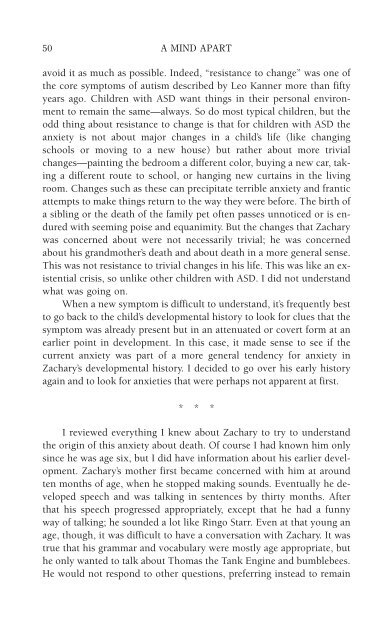978-1572305441
autism
autism
Create successful ePaper yourself
Turn your PDF publications into a flip-book with our unique Google optimized e-Paper software.
50 A MIND APART<br />
avoid it as much as possible. Indeed, “resistance to change” was one of<br />
the core symptoms of autism described by Leo Kanner more than fifty<br />
years ago. Children with ASD want things in their personal environment<br />
to remain the same—always. So do most typical children, but the<br />
odd thing about resistance to change is that for children with ASD the<br />
anxiety is not about major changes in a child’s life (like changing<br />
schools or moving to a new house) but rather about more trivial<br />
changes—painting the bedroom a different color, buying a new car, taking<br />
a different route to school, or hanging new curtains in the living<br />
room. Changes such as these can precipitate terrible anxiety and frantic<br />
attempts to make things return to the way they were before. The birth of<br />
a sibling or the death of the family pet often passes unnoticed or is endured<br />
with seeming poise and equanimity. But the changes that Zachary<br />
was concerned about were not necessarily trivial; he was concerned<br />
about his grandmother’s death and about death in a more general sense.<br />
This was not resistance to trivial changes in his life. This was like an existential<br />
crisis, so unlike other children with ASD. I did not understand<br />
what was going on.<br />
When a new symptom is difficult to understand, it’s frequently best<br />
to go back to the child’s developmental history to look for clues that the<br />
symptom was already present but in an attenuated or covert form at an<br />
earlier point in development. In this case, it made sense to see if the<br />
current anxiety was part of a more general tendency for anxiety in<br />
Zachary’s developmental history. I decided to go over his early history<br />
again and to look for anxieties that were perhaps not apparent at first.<br />
* * *<br />
I reviewed everything I knew about Zachary to try to understand<br />
the origin of this anxiety about death. Of course I had known him only<br />
since he was age six, but I did have information about his earlier development.<br />
Zachary’s mother first became concerned with him at around<br />
ten months of age, when he stopped making sounds. Eventually he developed<br />
speech and was talking in sentences by thirty months. After<br />
that his speech progressed appropriately, except that he had a funny<br />
way of talking; he sounded a lot like Ringo Starr. Even at that young an<br />
age, though, it was difficult to have a conversation with Zachary. It was<br />
true that his grammar and vocabulary were mostly age appropriate, but<br />
he only wanted to talk about Thomas the Tank Engine and bumblebees.<br />
He would not respond to other questions, preferring instead to remain



